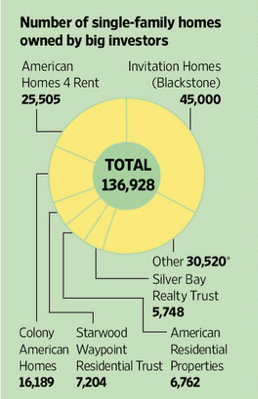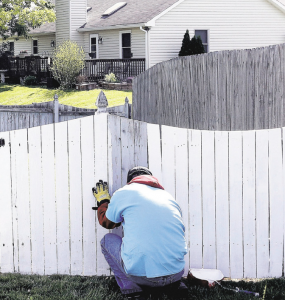 After a buying binge that helped drive the housing recovery, big investors are being forced to rethink the home-rental business.
After a buying binge that helped drive the housing recovery, big investors are being forced to rethink the home-rental business.
With bargains less plentiful, executives are slowing property purchases and turning their focus to generating steady income from tenants.
A spike in home prices over the past two years was quicker and more striking than many expected, squeezing returns and raising concerns about the industry’s growth prospects.
Small investors long have bought and sold homes. But two years ago when companies such as private-equity giant Blackstone Group BX +2.68% LP got into the business, backers said it could emerge as an asset class rivaling publicly owned apartment-rental companies, which own over 600,000 units and have a stock-market value of $88 billion.
The companies jumped into distressed markets, buying foreclosed properties and other homes at depressed prices with plans to fix them up, rent them and eventually sell at a profit. But buyers have slowed their pace after acquiring roughly 140,000 homes worth about $20 billion.
The reason: the unexpectedly sharp recovery in the price of homes over the past two years. In housing markets hardest hit by the bust—places like Phoenix, Las Vegas and much of Southern California—prices have risen as much as 55% off their postcrash lows. Nationally, prices are up 11.4% in the past two years, according to Zillow Inc.
“The distressed wave has largely passed,” said Jonathan Gray, head of real estate for New York-based Blackstone, which has spent $8.6 billion on some 45,000 homes and is the biggest player in the sector.
At the peak of its buying in July 2013, Blackstone was spending about $140 million a week on homes; now it is spending roughly $30 million to $40 million. “We didn’t anticipate prices going up 20% a year,” Mr. Gray said.

Rising prices have forced many investors to accept lower returns than they originally had projected in certain markets, or to buy homes in new cities where the price appreciation has been less rapid. Two years ago, investors could buy in Sunbelt markets such as Phoenix and Las Vegas for gross yields that were in the 15% range, according to Green Street Advisors. That has fallen to around 10%, often lower.
Many investors have decided to hold onto homes for longer than they originally expected because a larger proportion of investor returns is coming from rent instead of the home’s rising value.
“The initial investment thesis was to invest in these homes, make a nice return on the way, and be positioned to sell them for a nice profit,” said Gary Beasley, co-CEO of Starwood Waypoint Residential Trust, one of four public companies in the business. “As we got into it in the first year or two, it became clear that it might be more valuable to hold onto these homes in the long term, and really treat them like a scattered-site apartment building.”
A recent Morgan Stanley report found that buy-to-rent investors have bought about $400 million worth of homes a month in the first few months of 2014, down from about $520 million a month last year.
Investor demand has cooled for stock in the four rental-home companies that went public to fund their expansion. Only American Homes 4 Rent has a stock trading above its IPO price.
Paul Puryear, director of real-estate research for Raymond James & Associates, said investors have been cool to the stocks in part because home-price growth has leveled off, and because the industry still hasn’t grown to a critical mass. “There are too many skeptics in the market,” he said.
Industry executives say there is plenty of money to be made from renting. They say more households became renters after the downturn because of the high rate of foreclosure and the inability or unwillingness of many to buy.
Indeed, apartment rents have been steadily rising for 17 quarters, according to real-estate data firm Reis Inc. REIS +0.73% They are now 11% higher than they were in late 2009 when they hit their postcrash low, Reis says.
Irvine, Calif.-based American Property Group’s search for yield in the Midwest is paying off, according to its CEO, Saman Shams. Recent acquisitions include a three-bedroom house with a big front yard on North Cherry Lake Lane in Indianapolis. About a month ago, the company paid $67,000 for the home and is spending $15,000 on renovations.
The plan is to rent the house for $1,150 a month. After costs, this will produce just under $10,000 in net income, or an annual net yield of 11.2%, much higher than the 5% to 7% net yields most investors are getting in other markets. “We’re holding these homes for the long term,” Mr. Shams said.
Analysts say the growth of the industry will depend in large part on whether investors can continue to get the better of traditional buyers. Investors have had an advantage in many markets because they have been able to pay cash and close quickly.
But that could change if the economy improves and mortgages get easier to obtain. Individuals may be able to outbid investors because they can get lower interest rates and aren’t as concerned about rate of return.
